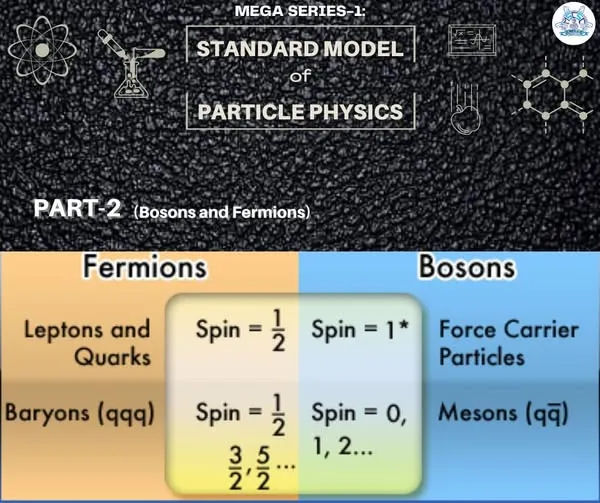
View full image
Standard Model of Particle Physics Part 2
All subatomic particles in the universe can be mainly divided into two categories: bosons and fermions, which have been mentioned in the previous episode.
𝗠𝗲𝗴𝗮 𝗦𝗲𝗿𝗶𝗲𝘀 -𝟭
“𝗦𝘁𝗮𝗻𝗱𝗮𝗿𝗱 𝗠𝗼𝗱𝗲𝗹 𝗼𝗳 𝗣𝗮𝗿𝘁𝗶𝗰𝗹𝗲 𝗣𝗵𝘆𝘀𝗶𝗰𝘀”
𝐏𝐚𝐫𝐭-𝟐
𝗘𝘅𝗽𝗹𝗮𝗻𝗮𝘁𝗶𝗼𝗻 𝗼𝗳 𝗙𝗲𝗿𝗺𝗶𝗼𝗻𝘀 𝗮𝗻𝗱 𝗕𝗼𝘀𝗼𝗻𝘀:
All subatomic particles in the universe can be mainly divided into two categories: bosons and fermions, which have been mentioned in the previous episode.
In this episode, the fundamental properties, functions, origin and differences of these two types of particles will be discussed.
All subatomic particles have several types of properties. Such as:
Quantum state, quantum position, charge, quantum orientation, spin quantum number, mass, orbital quantum number, etc.
The prerequisite for understanding the definition of these two types of particles, fermions and bosons, is to know what is meant by the spin of subatomic particles.
𝗤𝘂𝗮𝗻𝘁𝘂𝗺 𝘀𝗽𝗶𝗻:
The quantum spin of a subatomic particle basically indicates how the particle looks when viewed from different directions. For example:
A particle with a spin of 0 means that the particle looks the same when viewed from all possible directions.
A particle with a spin of 1 means that the particle looks different when viewed from different directions. However, if the particle is observed once from one direction, rotated 360 degrees and observed again from the same direction, the result of this observation will be the same as the result of the previous observation after rotation.
If the spin of a particle is 1/2 or any other half integral number (3/2,5/2,7/2,9/2 etc.), it can be brought back to its original position by giving a full rotation along two surfaces in a three-dimensional manner.
To understand fermions and bosons well, one more thing is necessary to know. That is “𝗣𝗮𝘂𝗹𝗶’𝘀 𝗲𝘅𝗰𝗹𝘂𝘀𝗶𝗼𝗻 𝗽𝗿𝗶𝗻𝗰𝗶𝗽𝗹𝗲”
𝗣𝗮𝘂𝗹𝗶’𝘀 𝗲𝘅𝗰𝗹𝘂𝘀𝗶𝗼𝗻 𝗽𝗿𝗶𝗻𝗰𝗶𝗽𝗹𝗲:
In simple terms, according to this principle, not all the qualities or properties of two or more subatomic particles can be the same. That is, all the properties of two or more particles, such as quantum state, quantum position, charge, quantum orientation, spin quantum number, mass, orbital quantum number, angular momentum, velocity, etc., can never be the same. Because if each of these fundamental properties of multiple particles is equal, then those particles will also become the same, and as a result, multiple particles will not exist separately. That is, even if all the properties are equal between two particles, at least one property will differ. For example:
When discussing an electron, basically its 4 properties are discussed.
These are:
Orbital quantum number, mass, charge and spin quantum number.
In the case of two or more electrons, it is not possible for each of these four properties to be equal. The meaning of the least unitary property will definitely differ. That is, two electrons may be in the same orbit, their charge and mass may be the same. But of course their spin quantum numbers will be different. This is known as Pauli's Exclusion Principle.
(𝗗𝗲𝗳𝗶𝗻𝗶𝘁𝗶𝗼𝗻 𝗮𝗻𝗱 𝘀𝘁𝘿𝘂𝗰𝘁𝘂𝗿𝗲 𝗼𝗳 𝗙𝗲𝗿𝗺𝗶𝗼𝗻𝘀) Definition and structure of fermions:
Fermions basically refer to those subatomic particles whose spin quantum number is half integral (1/2,3/2,5/2,7/2, etc.) and which obey the Pauli's Exclusion Principle. (So far, no particle with a half integral quantum spin number greater than 1/2 has been found.)
Due to the Pauli's Exclusion Principle, each fermion particle has a minimum difference of unity, so these particles occupy space, gain mass or inertia through interaction with the Higgs-Boson field, and play a role in the formation of all objects or matter in the universe as a whole. Because these particles remain the same due to differences in fundamental properties, they cannot exist at the same time. Rather, each particle occupies space separately as a different and unique entity.
(𝐖𝐨𝐫𝐤𝐬 𝐨𝐟 𝐅𝐞𝐫𝐦𝐢𝐨𝐧𝐬) Function of Fermions:
Since fermions, such as electrons, quarks, neutrinos, etc., have mass, each of them occupies space separately, and these particles play a role in forming the atoms of all substances or objects in the universe. However, they have no role in creating fundamental forces.
(𝗖𝗿𝗲𝗮𝘁𝗶𝗼𝗻 𝗼𝗳 𝗙𝗲𝗿𝗺𝗶𝗼𝗻𝘀) Origin of Fermions:
The main origin or source of creation of fermions is the invisible quantum field that is widespread throughout the universe. These fields include the electron field, quark field, Higgs-boson field, neutrino field, and even all types of boson fields. As soon as energy is transmitted to these fields, waves or waves are created in them. Since, according to the conditions of quantum mechanics, all fundamental particles sometimes behave like waves and sometimes like particles, the waves created in these fields are basically created from these fields. In this way, electrons, quarks and neutrinos and their antiparticles are created from the electron, quark and neutrino fields respectively. These issues have been discussed in detail in Einstein's 'quantum field' theory.
(𝗙𝗲𝗿𝗺𝗶𝗼𝗻𝘀 𝗗𝗲𝘁𝗲𝗰𝘁𝗶𝗼𝗻) Determining the presence of fermions:
Basically, two types of statistics or quantum thermodynamics are used to determine the presence of all subatomic particles in a small place in the universe. In this case, Fermi-Dirac statistics are used to determine the probability of which types of fermions and in what quantity they are possible to be present in a particular place.
(Definition and Structure of Bosons) Bose